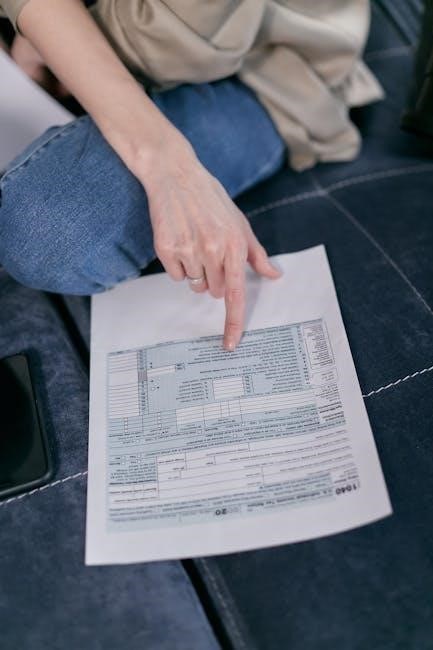Schedule O (Form 1120) is a crucial component of corporate tax filings, enabling accurate reporting of financial details and ensuring compliance with tax regulations․
Purpose of Schedule O
Schedule O (Form 1120) serves as a supplementary form for corporations to report specific financial details and adjustments․ Its primary purpose is to provide additional information about the corporation’s income, deductions, and credits that are not fully captured on Form 1120․ This schedule is essential for ensuring accurate tax liability calculations and compliance with IRS regulations․ It includes reporting adjustments to income, special deductions, and other items that require detailed disclosure․ Corporations must complete Schedule O to provide a comprehensive overview of their financial activities, ensuring transparency and adherence to tax filing requirements․ Proper completion of this schedule helps avoid errors and ensures the corporation’s tax return is accurate and complete․
Overview of Form 1120
Form 1120, the U․S․ Corporation Income Tax Return, is a critical document used by corporations to report their income, gains, losses, deductions, and credits to the IRS․ This form is essential for determining a corporation’s federal income tax liability․ Corporations, including C-corporations and certain other business entities, are required to file Form 1120 annually․ The form includes various schedules, such as Schedule O, which provides additional details necessary for accurate tax calculations․ By completing Form 1120, corporations ensure compliance with federal tax laws and provide a comprehensive overview of their financial activities․ This form is fundamental for maintaining proper tax records and meeting IRS requirements․

Who Must File Schedule O?
Corporations required to file Form 1120 must include Schedule O with their return․ This schedule provides necessary details for accurate tax compliance and reporting purposes․
Corporations Required to File
Domestic corporations obligated to file Form 1120 are required to include Schedule O․ This includes most C corporations, both large and small, excluding S corporations and foreign corporations, which have different filing forms․ Schedule O provides essential financial and compliance details, aiding the IRS in ensuring adherence to tax laws․ All corporations filing Form 1120 must submit Schedule O, as it is a mandatory component for accurate reporting and tax compliance․
Special Situations Requiring Filing
In certain cases, corporations must file Schedule O due to unique circumstances․ For instance, if a corporation is undergoing bankruptcy or is involved in a merger/acquisition, it must submit Schedule O to detail financial adjustments․ Additionally, corporations with changes in stock structure, such as issuing new classes of stock or significant stock redemptions, are required to file․ Corporations under audit or investigation by the IRS may also need to submit Schedule O to provide additional financial transparency․ Other special situations include corrections of prior errors or compliance with specific IRS requests․ These scenarios ensure the IRS has a complete understanding of the corporation’s financial standing․

Structure of Schedule O
Schedule O is divided into key sections, including income, deductions, gains, losses, and adjustments․ It consists of multiple parts, such as Part I (Financial Information) and Part II (Other Information), ensuring comprehensive reporting․
Parts of the Schedule
Schedule O (Form 1120) is organized into two primary parts: Part I (Financial Information) and Part II (Other Information)․ Part I requires detailed reporting of items such as gross receipts, total income, and deductions․ It also includes lines for depreciation, interest, and other expenses; Part II focuses on additional disclosures, such as the type of business activity, ownership changes, and other special situations․ Each part is divided into numbered sections, ensuring clarity and ease of navigation․ The structure is designed to capture essential financial and operational data, enabling accurate tax calculations and compliance with IRS requirements․ Proper completion of all parts is critical for corporate tax filings․
Key Sections to Complete
The key sections of Schedule O (Form 1120) are designed to capture critical financial and operational details․ Part I includes lines 1-11, focusing on income and deductions, such as gross receipts, total income, and cost of goods sold․ Lines 12-23 cover expenses like salaries, rent, and taxes․ Part II (lines 24-29) addresses additional disclosures, including depreciation adjustments and special deductions․ Line 30 summarizes total adjustments, ensuring accurate taxable income calculation․ Each section requires precise data entry to avoid errors․ Filers must carefully review these sections to ensure compliance with IRS requirements and accurate representation of the corporation’s financial position․

Step-by-Step Instructions
Start by gathering financial records and reviewing Form 1120․ Complete Schedule O by accurately entering income, deductions, and adjustments in the designated sections․ Double-check calculations and ensure compliance with IRS guidelines before submission․
Gathering Necessary Information
To accurately complete Schedule O (Form 1120), gather all relevant financial records and documents․ This includes income statements, balance sheets, and expense ledgers․ Ensure access to prior-year tax returns for comparison and consistency․ Collect details on dividends, capital gains, and other income sources․ Verify deductions, such as charitable contributions and interest expenses, with supporting receipts and invoices․ Review the corporation’s ownership structure, including shareholder information and stock details․ Ensure accurate accounting for depreciation, amortization, and other adjustments․ Organize all documents chronologically and cross-reference them with financial statements to avoid discrepancies․ This preparation ensures a smooth and precise completion of Schedule O․
Filling Out Each Section
When filling out Schedule O (Form 1120), carefully review each section and enter the required information accurately․ Start with Section 1, which includes income, deductions, and adjustments․ Ensure all figures align with the corporation’s financial records․ In Section 2, report dividends, special deductions, and other items as specified․ Enter each item on the appropriate line, referencing the IRS instructions for clarity․ Use the information gathered during the preparation phase to populate the fields accurately․ Double-check descriptions and amounts to avoid mismatches․ If a line does not apply, leave it blank or enter “0” as instructed․ Verify calculations and cross-reference with supporting documents before finalizing the schedule․
Calculations and Adjustments
Accurate calculations and adjustments are critical when completing Schedule O (Form 1120)․ Ensure all income, deductions, and credits are correctly computed, adhering to IRS guidelines․ Common calculations include adding income streams, subtracting deductions, and applying credits․ Adjustments may involve reclassifying items or correcting prior-year entries․ Verify each entry to prevent errors and ensure compliance․ Use accounting software or consult a tax professional to simplify complex computations․ Double-check mathematical accuracy to avoid discrepancies․ Properly document adjustments with supporting records․ Ensure all figures align with the corporation’s financial statements and comply with tax regulations․ Accurate calculations reduce the risk of audits and penalties, ensuring a smooth filing process․

Documentation Requirements
Accurate documentation is vital for Schedule O (Form 1120)․ Maintain detailed records, including financial statements, contracts, and ledgers, to support all reported income, deductions, and credits․
Supporting Documents Needed
When preparing Schedule O (Form 1120), ensure you have all necessary supporting documents to validate the information reported․ These include financial statements, such as balance sheets and income statements, as well as general ledgers and journals․ Contracts, agreements, and invoices related to income or expenses must also be retained․ Bank statements and canceled checks can provide additional verification of transactions․ Additionally, maintain records of depreciation schedules, accounts receivable, and accounts payable․ For tax-related items, keep copies of prior-year tax returns, extensions, and any IRS correspondence․ Having these documents organized ensures compliance and supports the accuracy of the information reported on Schedule O․
- Financial statements and ledgers
- Contracts and invoices
- Bank statements and records
- Depreciation and accounts schedules
- Tax-related documents
These records help validate entries and support compliance with IRS requirements․
Retention of Records
Retention of records for Schedule O (Form 1120) is essential for compliance and audits․ Corporations must keep all supporting documents, including financial statements, ledgers, journals, contracts, and invoices, for at least three years from the return’s filing date․ In cases of underreported income or overclaimed credits, records should be retained for six years․ If fraud is suspected or no return is filed, records must be kept indefinitely․ Ensure records are stored securely, both physically and digitally, and are well-organized for easy access․ Backup copies are recommended to prevent data loss․ Proper retention ensures compliance with IRS requirements and facilitates a smooth audit process if necessary, avoiding potential penalties and legal issues․
- Minimum retention period: 3 years
- Extended retention for errors or omissions: 6 years
- Indefinite retention for fraud or no filing
- Secure storage: physical and digital
- Maintain backup copies

Common Mistakes to Avoid
Avoid errors in reporting income, miscalculating deductions, and overlooking filing deadlines․ Ensure accurate completion of all sections to prevent penalties and delays in processing Schedule O․
- Inaccurate income reporting
- Incorrect calculations
- Missing deadlines
Errors in Reporting Income
Accurate income reporting is critical on Schedule O․ Common errors include misclassifying income types, failing to report all taxable income, and incorrectly calculating adjustments․ Ensure all income streams, such as dividends, rents, and royalties, are properly documented and categorized․ Overlooking smaller income sources or misreporting them can lead to discrepancies․ Additionally, incorrect accounting methods or failing to reconcile income with financial statements may trigger IRS scrutiny․ Always cross-reference income figures with original records and ensure compliance with IRS guidelines to avoid penalties․ Double-checking entries before submission helps prevent costly mistakes and ensures compliance with tax regulations․
Incorrect Calculations
Incorrect calculations on Schedule O can lead to significant errors in a corporation’s tax return․ Common mistakes include miscalculating deductions, credits, or adjustments․ For instance, improperly computing depreciation, incorrectly applying tax credits, or failing to account for deferred taxes can result in inaccurate financial reporting․ Additionally, errors in calculating net operating losses or misapplying carryover amounts can compound issues․ It is essential to ensure all numerical entries are precise and align with the corporation’s financial records․ Using tax software or consulting a tax professional can help mitigate these risks․ Always double-check calculations before submission to prevent costly corrections or audits later․ Accuracy is paramount to avoid delays or penalties․

Importance of Accuracy
Accuracy in Schedule O is crucial to avoid IRS issues․ Errors can lead to penalties or audits․ Ensure all data aligns with financial records for proper compliance and stakeholder trust․
Consequences of Errors
Errors in Schedule O can result in severe penalties, including fines and interest on unpaid taxes․ The IRS may delay processing the return, leading to prolonged resolution․ Inaccuracies can trigger audits, requiring additional documentation and potentially uncovering more issues․ Overstated deductions or underreported income may lead to recalculations of tax liability, increasing the amount owed․ Shareholders or stakeholders could face repercussions if errors affect distributions or credits․ Persistent inaccuracies might raise suspicions of tax evasion, leading to legal consequences․ Ensuring accuracy is vital to maintain compliance and avoid these outcomes․ Corporations should implement rigorous review processes to minimize risks․
Best Practices for Compliance
To ensure compliance with Schedule O requirements, corporations should adopt best practices such as double-checking all entries for accuracy and completeness․ Reconciling Schedule O with financial statements and other tax forms is essential to avoid discrepancies․ Consulting a tax professional or legal advisor can help navigate complex areas․ Maintaining organized and detailed documentation is crucial for audits․ Corporations should also ensure timely filing to avoid penalties․ Regularly reviewing IRS guidelines and updates can prevent errors․ Implementing internal review processes and cross-verifying data before submission are key to maintaining compliance․ These practices help mitigate risks and ensure adherence to tax regulations․

Verification and Submission
Ensure Schedule O is thoroughly reviewed for accuracy before submission․ Sign and date the form, then submit it with Form 1120 by the designated deadline․
Reviewing the Schedule
Thoroughly review Schedule O (Form 1120) to ensure all information is accurate and complete․ Check for errors in calculations, inconsistencies in reported data, and missing signatures․ Verify that all items align with the corporation’s financial records and comply with IRS guidelines․ Ensure all applicable sections are filled out correctly, and no required fields are left blank․ Cross-reference data with other forms, such as Form 1120, to maintain consistency․ Confirm that the corporate officer’s name, title, and signature are included․ Double-check mathematical calculations to avoid discrepancies․ If unsure, consult a tax professional to ensure compliance and accuracy before submission․
Submission Process
Schedule O (Form 1120) must be submitted to the IRS along with the corporation’s tax return․ Most corporations are required to file electronically using the IRS e-file system, which streamlines the process and reduces errors․ For paper filing, the completed Schedule O must be attached to Form 1120 and mailed to the IRS address listed for the corporation’s state․ Ensure the form is signed by an authorized corporate officer․ The submission deadline is generally the 15th day of the fourth month after the tax year ends (e․g․, April 15 for a calendar-year corporation)․ Extensions may be requested, but the form must still be submitted by the extended deadline․

Examples and Case Studies
Examples and case studies illustrate practical applications of Schedule O․ They cover scenarios like manufacturing, retail, and service industries, detailing income types, deductions, and credits․ These real-world examples help clarify complex reporting requirements, ensuring accurate compliance with IRS guidelines․
Sample Completed Schedule
A sample completed Schedule O provides a clear example of how to report a corporation’s financial information․ It includes detailed entries for income, deductions, and credits, with accurate calculations; For instance, a manufacturing company might report $500,000 in gross receipts, $200,000 in cost of goods sold, and $150,000 in operating expenses․ The sample demonstrates proper line-by-line completion, ensuring all sections are filled out correctly․ It also shows how to account for depreciation, interest, and other adjustments․ A completed sample is invaluable for understanding how to present financial data accurately and comply with IRS requirements․ It serves as a practical guide for corporations preparing their Schedule O․
Real-World Application Scenarios
In real-world scenarios, Schedule O is essential for corporations to accurately report their financial activities․ For example, a manufacturing corporation might use Schedule O to detail its gross receipts from product sales, cost of goods sold, and operating expenses․ A retail company could apply it to report income from multiple store locations, while a service-based business might focus on income from consulting fees․ Additionally, corporations with international operations use Schedule O to account for foreign-sourced income․ Special situations, such as mergers or acquisitions, also require Schedule O to report changes in corporate structure or ownership․ These scenarios highlight the form’s versatility in capturing diverse financial situations, ensuring compliance with IRS reporting standards․

Interrelation with Other Forms
Schedule O (Form 1120) is closely connected to Form 1120-S for S corporations and Schedule K-1 for shareholder reporting, ensuring seamless integration of corporate financial data․
Connection to Form 1120-S
Schedule O (Form 1120) is directly connected to Form 1120-S, which is used by S corporations to report income, deductions, and credits․ While Schedule O is specific to C corporations, its data may flow into Form 1120-S in certain situations, particularly when dealing with complex corporate structures or consolidated returns․ Both forms require similar financial details, such as income, expenses, and tax liability, ensuring consistency in reporting․ Taxpayers must carefully review both forms to align data accurately, avoiding discrepancies that could lead to errors or delays in processing․ Understanding this connection is essential for maintaining compliance with IRS requirements and ensuring proper tax filings for both C and S corporations․
Link to Schedule K-1
Schedule O (Form 1120) and Schedule K-1 serve distinct purposes but are interconnected in tax reporting․ Schedule K-1 is used by pass-through entities like partnerships and S corporations to report partner or shareholder distributions, while Schedule O is part of the C corporation tax return․ Although they cater to different entity types, both schedules ensure accurate reporting of financial activities to the IRS․ While Schedule O does not directly link to Schedule K-1, understanding both is crucial for entities with complex structures or ownership ties․ Proper completion of both schedules ensures compliance and avoids discrepancies in tax filings․
Accurate completion of Schedule O ensures compliance with IRS requirements․ Corporations must carefully review all sections, adhere to guidelines, and avoid errors to prevent penalties or delays․
Schedule O (Form 1120) is essential for corporations disclosing certain transactions or events․ It ensures compliance with IRS rules and provides transparency․ Corporations must file Schedule O if they engage in specific activities, such as changes in stock structure or distributions․ The form requires detailed information about transactions, including dates, descriptions, and financial impacts․ Proper documentation and accurate reporting are crucial to avoid penalties․ Corporations must maintain records to support disclosures․ Errors or omissions can lead to delays or audits․ Understanding the form’s requirements and seeking professional advice, if needed, ensures proper filing․ Compliance with Schedule O is vital for maintaining trust and avoiding legal issues․
Final Tips for Filing
Ensure all information is accurate and complete before submitting Schedule O․ Double-check calculations and verify that all required sections are filled out․ Consulting a tax professional can help navigate complex situations․ Organize all supporting documents and maintain clear records for audit purposes․ Submit electronically for faster processing and to reduce errors․ Review IRS guidelines annually for updates․ Ensure timely filing to avoid penalties․ Pay attention to deadlines and request extensions if needed․ Keep a copy of the filed Schedule O for your records․ Verify that all disclosures align with corporate activities․ Accuracy and compliance are key to a smooth filing process․